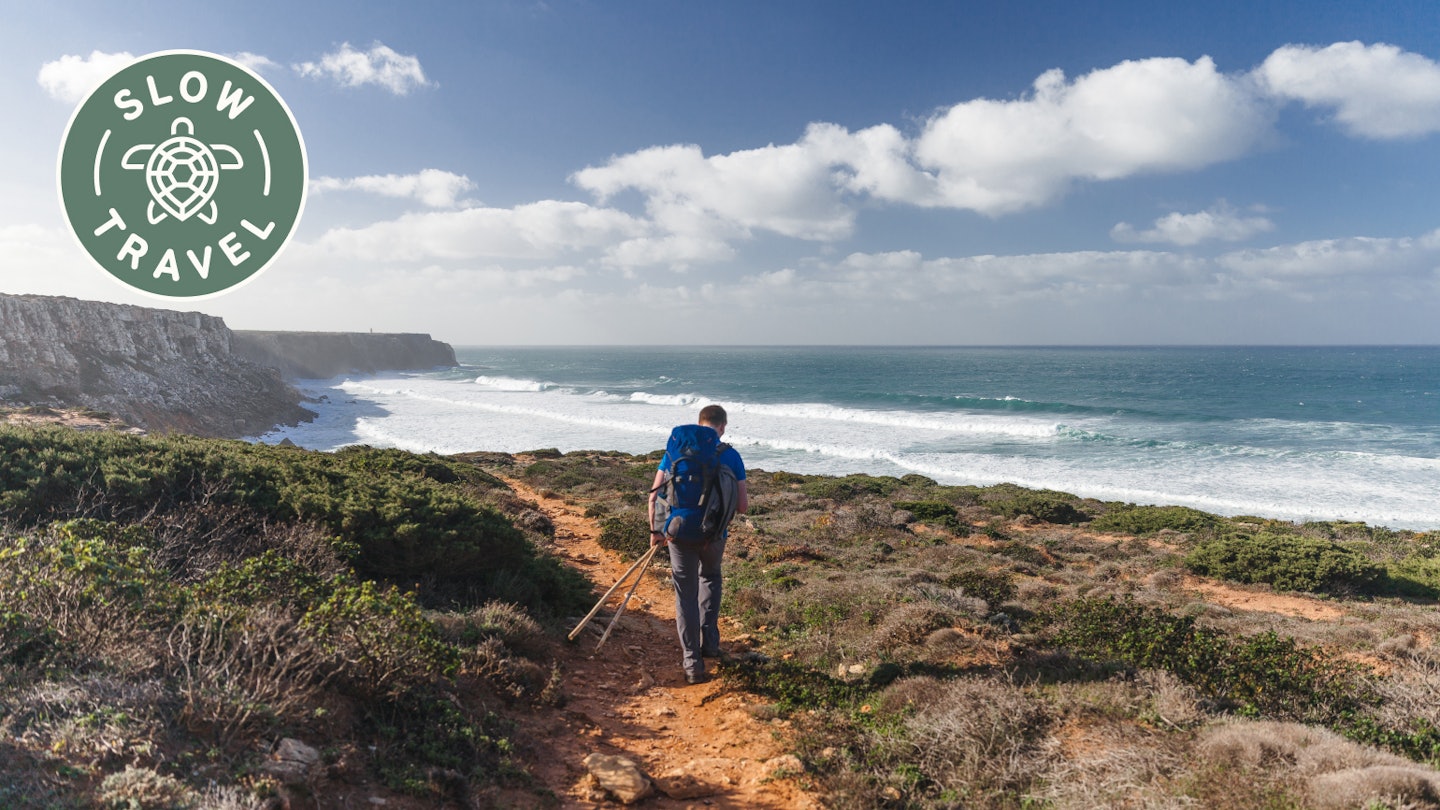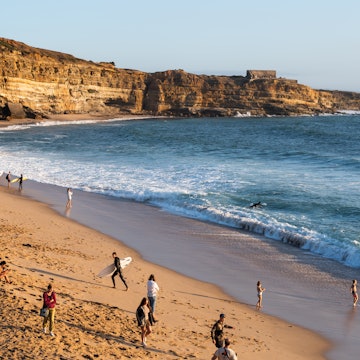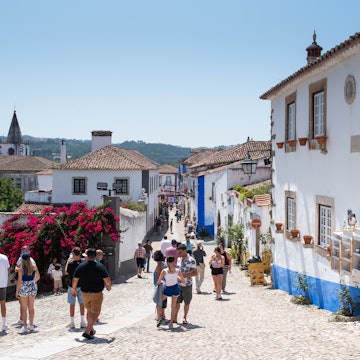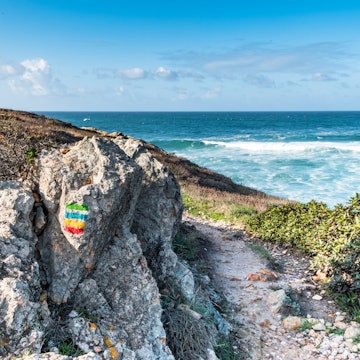

The Fisherman’s Trail along Portugal’s southwestern coast takes you past dramatic scenery and postcard-perfect villages © Marlene Marques / Lonely Planet
Follow the sand, cliffs and capes along the coast from the Alentejo to the Algarve.
I’m at São Torpes Beach, in the Alentejo, Portugal, next to the sign that marks the beginning of the Fishermen’s Trail – a world-famous path that’s part of the Rota Vicentina.
In the distance, the skyline is metallic gray: Sines, the nearest town, is one of Portugal’s main maritime ports and home to major oil companies.
But this sign marks a 180-degree change in the landscape. Industry will give way to nature, and for 140 miles (226km), the coastline of Parque Natural do Sudoeste Alentejano e Costa Vicentina will reveal itself and challenge me with every step.

If, like me, you have always felt a strong connection to the maritime landscape, this trail will win you over. The way follows the coastline along old fishermen’s paths and through some of the most beautiful villages on the Portuguese coast.
Yet it’s a challenge for sure. The Fishermen’s Trail consists primarily of sand paths with some steep inclines, making it physically demanding and entirely exposed to the heat, cold, rain and wind. And it’s done entirely on foot.
Depending on your physical condition, you can complete the whole trail in 13 days, with the route divided into 13 stages. But I recommend spending some more time to fully appreciate the journey.

At every stop, a Portuguese postcard
The first stretch, between São Torpes and Porto Covo, is the easiest of the whole trail. Which is just as well, since I need to keep my spirits up as I consider the challenge I’ve set for myself.
It’s springtime – one of the best times to walk the Fishermen’s Trail. Wildflowers and aromatic bushes adorn the path. The sound of insects is interrupted only by the crashing waves or the occasional passing seagull.
The tranquility begins to sink in; it will will be a constant throughout this trip. When we are used to the city noise and the speed of life, the mind seems to find the silence and stillness unnatural.
This peaceful atmosphere is only disrupted as we approach the villages on the Fishermen’s Trail. Porto Covo is first on the list. With its whitewashed houses, walls trimmed in blue and the occasional pop of color from a pot of flowers or clothes laid out on the line, it’s a the picture postcard of a Portuguese village. Father along is picture-perfect Vila Nova de Milfontes. Stretching along the Mira River, the village is ideal for a rest.

In Vila Nova de Milfontes, you can cheat a little on your adventure: crossing the river by boat to the next stage will save you some kilometers and travel time. The access to the harbor is near Forte de São Clemente, built in 1602 to defend the village from pirate attacks.
Other beautiful towns populate the trail to the south: Zambujeira do Mar, with its extensive beach; Odeceixe, which has one of the few windmills still in operation; and, over the border of the Algarve region, Aljezur, with the emblematic 10th-century castle on top of the hill overlooking the village.
From here, the typically Algarvian chimneys appear in greater numbers on top of the white houses found in places like Arrifana or Carrapateira.

Hiking through history
As we go down the map and cross the different areas of the park, the landscape of the Fishermen’s Trail starts to change. The low cliffs now give way to imposing scenery that hides stories from the past.
The stretch between Aljezur and Arrifana, passing Monte Clérigo, follows increasingly high cliff tops and leads through the Ribat da Atalaia, ruins of an ancient Islamic fortress-convent occupied by 12th-century monks. As I look back, I’m amazed at the coast outline, the deserted beaches and the long way I’ve already traveled.
The scenario repeats itself from Carrapateira to Vila do Bispo, and the medieval archaeological remains of the Islamic settlement of Ponta do Castelo, just before reaching Praia do Amado. Archaeologists claim that people once used it as an observatory for fishing.

No wonder this is called the Fishermen’s Trail. In a region along the rough Atlantic, fishing has always been – and will always be – a livelihood for the local people. Along the way, we also come across small fishing ports still in operation, such as the Lapa de Pombas near Almograve, or the Entrada da Barca by Zambujeira do Mar.
Into the sea
The Fishermen’s Trail also includes two large capes: Cape Sardão on the way to Zambujeira, and Cape São Vicente, reaching Sagres. On both, imposing lighthouses warn boats that the land is closer than they might think.
The atmosphere in these places is entirely different, however.

Near the Cape Sardão lighthouse, the trail winds through aromatic bushes and catches the eye of the white storks that have chosen the quiet of these cliffs to build their nests. At Cape São Vicente’s lighthouse, quiet gives way again to the hustle and bustle of people, cars, tourist buses, hot dog trucks and souvenir stands. It’s a slap of reality brought about by one of Sagres’ main tourist attractions.
The final stretch
For many hikers (including me) Sagres marks the end of the adventure along the Fishermen’s Trail. Yet the path it doesn’t stop there. To complete it, you’d have to spend a few more days following the southern coast to Lagos, passing through Salema and Luz. Along the way, beaches like Barranco, Ingrina or Zavial will make this last great effort totally worthwhile.

How you can tackle the Fishermen’s Trail
When to go and where to start
It’s best to walk the Fishermen’s Trail between September and June, avoiding Portugal’s hottest months. You can start from north to south, at São Torpes beach in Sines; or from south to north, in Lagos, near the train station. Comprehensive signposts lie along the trail in both directions.
Sleeping and eating
The villages along trail offer local accommodations for overnight stays; campsites are another option. You can find them in São Torpes, Vila Nova de Milfontes, Zambujeira do Mar, Odeceixe, Aljezur, Sagres or Salema.
Villages have restaurants and stores for stocking up. Some of the delicacies to try along the way are the fish at Porto das Barcas (Vila Nova de Milfontes), any pizza at Piccolino (Zambujeira do Mar), breakfast at Ao Largo (Odeceixe), the cakes at Pão do Rogil (Rogil) and the stuffed squid at Tasca do Careca (Vila do Bispo).
What to bring with you
Depending on the time of year, bring layers to protect you from the heat or cold. Walking sticks are always a good help, as is footwear suitable for walking on sand. A raincoat can be helpful in the winter months, and a hat and sunscreen are always a must.
If you carry a backpack, keep it under 20% of your body weight and bring plenty of water to stay hydrated.
















